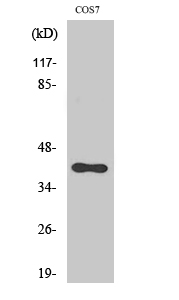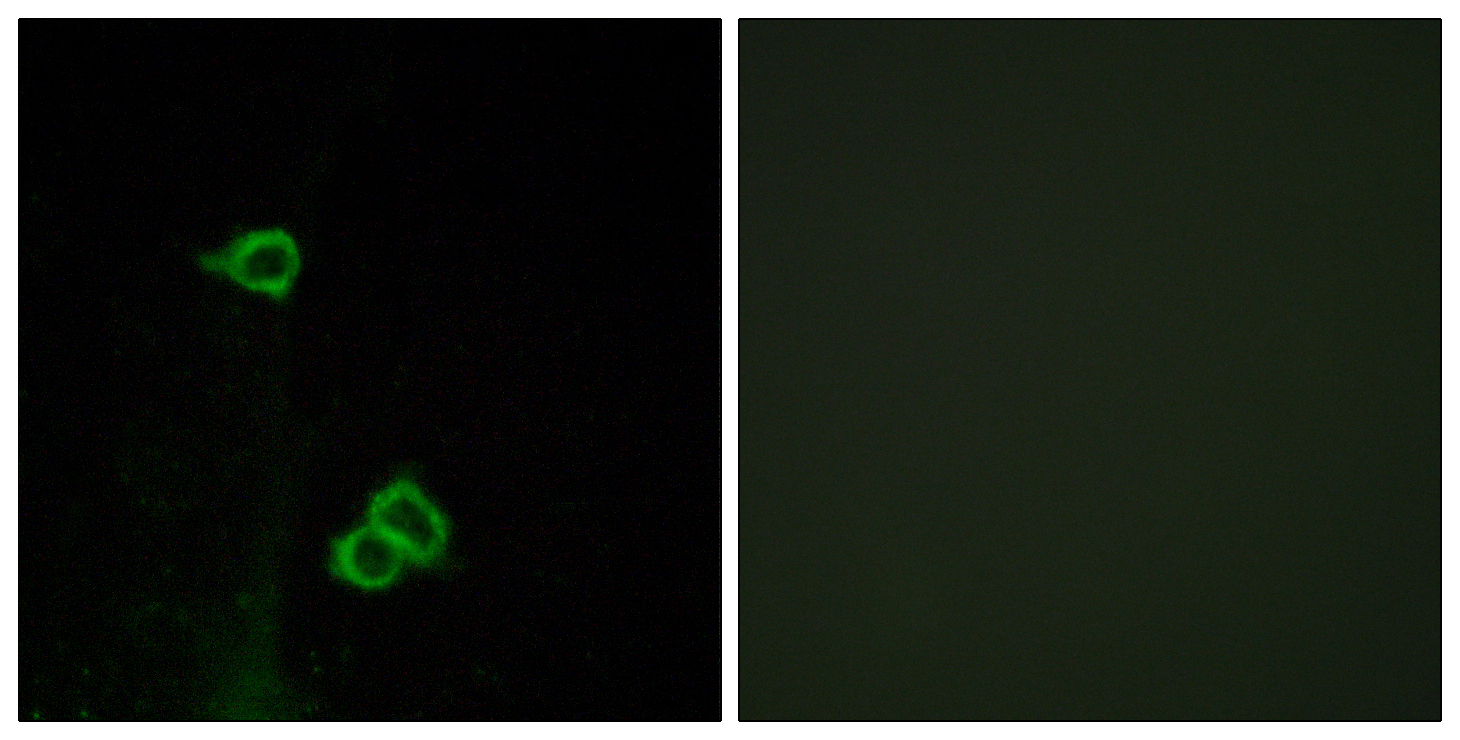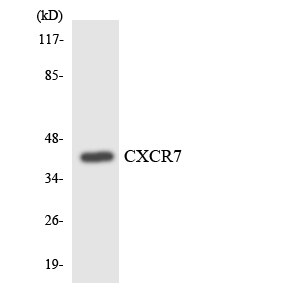CXCR-7 Polyclonal Antibody
- Catalog No.:YT1162
- Applications:WB;IF;ELISA
- Reactivity:Human;Mouse;Rat;Monkey
- Target:
- CXCR-7
- Fields:
- >>Cytokine-cytokine receptor interaction;>>Viral protein interaction with cytokine and cytokine receptor
- Gene Name:
- CXCR7
- Protein Name:
- C-X-C chemokine receptor type 7
- Human Gene Id:
- 57007
- Human Swiss Prot No:
- P25106
- Mouse Gene Id:
- 12778
- Mouse Swiss Prot No:
- P56485
- Rat Gene Id:
- 84348
- Rat Swiss Prot No:
- O89039
- Immunogen:
- The antiserum was produced against synthesized peptide derived from human CXCR7. AA range:311-360
- Specificity:
- CXCR-7 Polyclonal Antibody detects endogenous levels of CXCR-7 protein.
- Formulation:
- Liquid in PBS containing 50% glycerol, 0.5% BSA and 0.02% sodium azide.
- Source:
- Polyclonal, Rabbit,IgG
- Dilution:
- WB 1:500 - 1:2000. IF 1:200 - 1:1000. ELISA: 1:20000. Not yet tested in other applications.
- Purification:
- The antibody was affinity-purified from rabbit antiserum by affinity-chromatography using epitope-specific immunogen.
- Concentration:
- 1 mg/ml
- Storage Stability:
- -15°C to -25°C/1 year(Do not lower than -25°C)
- Other Name:
- CXCR7;CMKOR1;GPR159;RDC1;C-X-C chemokine receptor type 7;CXC-R7;CXCR-7;Chemokine orphan receptor 1;G-protein coupled receptor 159;G-protein coupled receptor RDC1 homolog;RDC-1
- Observed Band(KD):
- 41kD
- Background:
- This gene encodes a member of the G-protein coupled receptor family. Although this protein was earlier thought to be a receptor for vasoactive intestinal peptide (VIP), it is now considered to be an orphan receptor, in that its endogenous ligand has not been identified. The protein is also a coreceptor for human immunodeficiency viruses (HIV). Translocations involving this gene and HMGA2 on chromosome 12 have been observed in lipomas. [provided by RefSeq, Jul 2008],
- Function:
- caution:Was originally (PubMed:1675791) thought to be the receptor for VIP.,function:Receptor for CXCL12/SDF1. Acts as coreceptor with CXCR4 for a restricted number of HIV isolates.,online information:CXC chemokine receptors entry,similarity:Belongs to the G-protein coupled receptor 1 family.,tissue specificity:Expressed in monocytes, basophils, and B-cells. Lower expression in CD4+ T-lymphocytes and natural killer cells.,
- Subcellular Location:
- Cell membrane ; Multi-pass membrane protein . Early endosome . Recycling endosome . Predominantly localizes to endocytic vesicles, and upon stimulation by the ligand is internalized via clathrin-coated pits in a beta-arrestin-dependent manner. Once internalized, the ligand dissociates from the receptor, and is targeted to degradation while the receptor is recycled back to the cell membrane. .
- Expression:
- Expressed in monocytes, basophils, B-cells, umbilical vein endothelial cells (HUVEC) and B-lymphoblastoid cells. Lower expression detected in CD4+ T-lymphocytes and natural killer cells. In the brain, detected in endothelial cells and capillaries, and in mature neurons of the frontal cortex and hippocampus. Expressed in tubular formation in the kidney. Highly expressed in astroglial tumor endothelial, microglial and glioma cells. Expressed at low levels in normal CD34+ progenitor cells, but at very high levels in several myeloid malignant cell lines. Expressed in breast carcinomas but not in normal breast tissue (at protein level).
C-X-C chemokine receptor type 7 antibody enhances neural plasticity after ischemic stroke Neural Regeneration Research Shan-Shan Zhao WB Rat striatum
- June 19-2018
- WESTERN IMMUNOBLOTTING PROTOCOL
- June 19-2018
- IMMUNOHISTOCHEMISTRY-PARAFFIN PROTOCOL
- June 19-2018
- IMMUNOFLUORESCENCE PROTOCOL
- September 08-2020
- FLOW-CYTOMEYRT-PROTOCOL
- May 20-2022
- Cell-Based ELISA│解您多样本WB检测之困扰
- July 13-2018
- CELL-BASED-ELISA-PROTOCOL-FOR-ACETYL-PROTEIN
- July 13-2018
- CELL-BASED-ELISA-PROTOCOL-FOR-PHOSPHO-PROTEIN
- July 13-2018
- Antibody-FAQs
- Products Images

- Western Blot analysis of various cells using CXCR-7 Polyclonal Antibody diluted at 1:2000

- Immunofluorescence analysis of COS7 cells, using CXCR7 Antibody. The picture on the right is blocked with the synthesized peptide.

- Western blot analysis of the lysates from RAW264.7cells using CXCR7 antibody.



